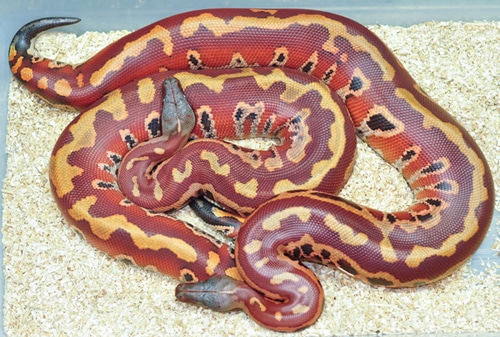Updated January 30, 2023 In our minds, blood pythons are the ideal captive for the serious python enthusiast. They’re gorgeous, they’re good-sized
Updated January 30, 2023
In our minds, blood pythons are the ideal captive for the serious python enthusiast. They’re gorgeous, they’re good-sized snakes without being unmanageable and they require just enough “snake savvy” for a keeper to grow and refine his or her herpetocultural skills. In this article, we will discuss the ins and outs of successful blood python husbandry.
The Right Type of Enclosure
Blood pythons (Python brongersmai) don’t require fussy, elaborate setups. In fact, these snakes seem to do best with simple enclosures, following a few specific guidelines that are easy to meet and maintain. Blood python husbandry, like that of many snakes, is a matter of balance. Not too hot or too cold, not too wet or too dry, not too big or too small, and so forth. With this in mind, there are a few points to consider when setting up an enclosure for your blood python that will make the entire “balancing act” much easier.
Blood pythons do not seem to thrive in screen-topped, glass aquariums to the extent that they do in other types of enclosures. Glass does not provide much insulation, and screen-topped cages do no not retain heat or humidity. This tends to translate into a less-than-ideal environment for the snake, and extra work for the keeper. Avoiding this type of cage in favor of a purpose-made enclosure built specifically for use with reptiles will make creating the correct captive environment much simpler for the keeper, and less stressful for the snake.
An appropriately sized enclosure is necessary all throughout the life of your blood python. It’s obvious that an adult blood python cannot live comfortably in an enclosure that is small and secure enough for a hatchling. The same logic applies for hatchlings and juveniles—they become overwhelmed and insecure in a cage large enough for an adult, to the point that they may become stressed and stop feeding. The size of the cage you use will also help determine how you heat it, how much ventilation is required, even the type of substrate and water bowl you use, so keep the big picture in mind when making your cage selections.
Cage Size & Accessories
Although you don’t need to mimic our setup exactly in order to be successful with your blood python, we do offer the following cage sizes as good guidelines to follow for different stages of your blood python’s life. All of our snakes, from newborn hatchlings to mature adults, are housed in rack systems from Animal Plastics. Our hatchling tubs measure 10 inches long, 6 inches wide and 4 inches tall. Ventilation is provided by melting holes in the short ends of each box with a soldering iron (use caution with hot iron and melting plastic).
Our adult blood pythons are housed in large, Christmas tree storage bins measuring 52 inches long, 20 inches wide and 12 inches tall, also contained within racks. These tubs easily accommodate the size and bulk of an adult blood, giving them a little more than 7 square feet of space.
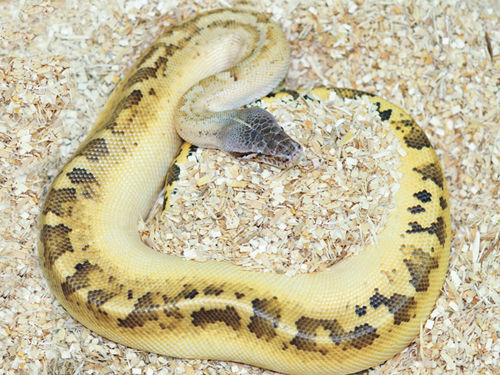
Ivory blood python. Photo by Ryan and Kara Norris
Read More
Blood and Short-tailed Python Care Sheet
For those who prefer display enclosures, we recommend an enclosure measuring 48 inches long, 24 inches wide and 24 inches tall, depending on keeper preference. This footprint is common in terrestrial enclosures and provides sufficient space for a large, mature blood python.
Within these enclosures, paper makes a great substrate. When given multiple sheets of newspaper, Kraft Paper or butcher paper, these snakes will often sit between the layers, so that the substrate also doubles as a hide. Humidity is slightly higher underneath the layers of paper, increased by moisture from the snake’s normal respiration.
For those who prefer a more natural appearance to substrate, milled cypress mulch, chipped aspen (Sani-Chips) or shredded aspen can make good alternatives. Take care to ensure that wood particle substrates are free from excessive dust, which may irritate a blood python’s respiratory system. Also, make sure that any shredded or chipped wood substrate used in your blood python’s enclosure does not contain cedar, as the oils from this wood are toxic to reptiles. Remove soiled substrate when encountered, and always make sure that the cage smells fresh, without overwhelming odors of any sort.
We do not recommend the use of wood particle substrates with young hatchlings, as these substrates tend to have a drying effect on small snakes. Hatchling blood pythons are best housed on paper towels, which may be dampened as necessary to help prevent dehydration. They should be maintained at 60 to 70 percent humidity, so misting the paper towels every other day should suffice.
Water bowls are also straightforward. We provide 8-ounce deli cups for hatchlings and juveniles, 16-ounce containers for subadults and 24-ounce containers for adults. The larger containers are held within 4-inch diameter PVC couplings, which add stability to the deli containers, thereby minimizing spills. Blood pythons drink copiously, so it is important to ensure that fresh, clean water is available at all times. Check daily and replace stale or soiled water immediately.
Blood pythons also love to soak, so if you offer a container large enough for your snake to do so, it probably will do so sooner rather than later. While it is considered normal behavior for a blood python to soak, if yours does so for days on end, rarely leaving the bowl, make sure that the snake is not trying to escape temperatures that are too warm. You should also make sure that the snake is not irritated by an infestation of mites, which it will try to relieve by spending long periods of time in its water bowl. Tiny black specks, nearly identical to poppy seeds, found floating in the water are a sign of mites.
Temperature
We routinely maintain our blood pythons at ambient temperatures of 80 to 82 degrees Fahrenheit, from hatchlings to adults. It is a common misconception that blood pythons must be kept especially hot. In fact, high temperatures tend to cause them discomfort and undue stress. When we do offer supplemental heat, it is via heat tape in the range of 86 to 88 degrees at one end of the enclosure. The cool end remains at 80 degrees.
No matter how you choose to heat your blood python’s enclosure, a thermostat or rheostat should always be used to prevent overheating. We also highly recommend the use of infrared thermometers or “temp guns” to measure temperatures. The temp gun is an extremely useful tool that allows a keeper to point and shoot to assess temperature, with results provided instantly on a digital display.
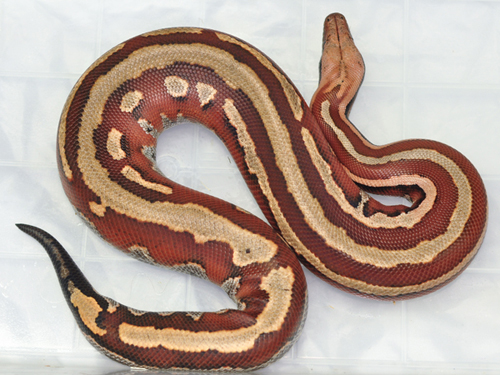
PE stripe blood python. Photo by Ryan and Kara Norris
Humidity
Another frequently heard misconception about blood python husbandry is that these snakes must be kept very wet. In reality, they do quite well with cage humidity levels of 60 to 70 percent, which may be controlled simply with a proper setup. Your blood python’s skin is a good indicator of humidity that is either insufficient or excessive. With low humidity, pronounced dimpling of the scales and spectacles may occur, and the snake will often experience incomplete sheds. This is typically corrected by providing a larger water bowl or misting the snake as necessary. We mist daily if the conditions are dry or if the snake is shedding. Otherwise, we mist every other day. Be careful when reducing ventilation to raise humidity, as it is important that a blood python’s enclosure provides sufficient airflow to avoid becoming stagnant.
A blood python that is consistently exposed to too-high humidity will take on a wet, wrinkled, shiny appearance. Some keepers mistake the wrinkling for dryness and exacerbate the problem by adding extra moisture. A dank, wet, warm cage is the perfect environment for bacterial and fungal growth, both of which may lead to health issues for your blood python, so take care not to let the cage stay wet for long periods of time. Wet cages are easily remedied by providing a more absorbent substrate, additional ventilation or a smaller water container, if necessary.
Feeding
Rats are the ideal prey for blood pythons. While some hatchling blood pythons show an initial preference for hopper mice, they quickly graduate to rat pups and continue to eat rats for the rest of their lives. Blood pythons have slow metabolisms, and therefore, they don’t need huge meals in order to maintain a healthy adult weight, regardless of their girthy appearance. A solid, robust blood python should still have a discernible dorsal ridge and a gentle slope from the snake’s back to its sides. It shouldn’t appear flat or round across the dorsal surface. Obesity in bloods contributes to poor breeding results, and it can also make respiratory issues difficult to overcome.
Most of our adults eat medium or large rats, and our largest bloods eat retired breeder rats every two weeks. Blood pythons love to eat, and for the most part, they tend to be fantastic feeders. It is important to keep in mind that these snakes are easily made obese if their enthusiasm for food is catered to on a frequent basis or with super-sized prey items. If you choose to feed every week, try offering smaller feeders so that your snake maintains a healthy weight. We recommend the use of feeding tongs to safely offer food, whether feeding pre-killed or frozen-thawed. Otherwise, in the case of shy feeders needing more time, dead rats may be left on the cage floor. Never leave a live rat unattended with your blood python, as a scared rodent can cause significant damage—even death—to blood python when left for a length of time.
Blood pythons can be conditioned to accept frozen-thawed, warmed rats as prey. Your blood python may already eat frozen-thawed prey when acquired from a breeder. If not, it typically just takes time and patience to help your snake make the transition. Ensuring that frozen rats are thoroughly thawed and heated up is a necessity. We find that a surface temperature (use your temp gun!) of 105 degrees Fahrenheit works well to trigger a blood python’s feeding response. This may be achieved by placing the rat on a heat pad or heating it with a hair dryer for a few seconds just prior to offering it to your snake.
Some blood pythons are finicky when initially making the transition to thawed food. In this case, it may be necessary to employ a “tough-love” approach and allow the snake to skip a meal or two in order to whet its appetite. The use of feeding tongs is again quite helpful, especially if the snake is used to taking fresh-killed rats in this manner.
Handling
Wild-caught blood pythons have long carried a reputation for being temperamental, flighty snakes. Fortunately, the opposite is usually true with their captive-bred-and-born counterparts. Blood pythons that have been handled gently and consistently from a young age typically mature to placid, docile adults. Working with a big, friendly, beautiful red snake is quite a thrill!
Baby blood pythons may be nervous and defensive, simply due to the fact that they aren’t sure yet whether or not you intend to eat them. As such, they may thrash, flail or bite in reaction to too much handling. We recommend keeping initial handling sessions short and sweet—no more than a few minutes at a time, once or twice a day. Deliberate movements and careful handling will help to develop a good working relationship with your young blood python, and will establish a pattern of calm interaction that the snake will come to anticipate.
Never grab your blood python or swing it about heedlessly. These are solid, heavy-bodied snakes that appreciate being carefully supported and cradled. They tend to become uncomfortable when dangled, and careless handling may cause a “one-step-forward-two-steps-back” scenario when attempting to gentle a nervous snake. Always end handling time on a positive note, with the snake sitting calmly—even if only for a few moments—before returning to its enclosure.
Close Cousins: the short-tailed trifecta
Blood pythons (Python brongersmai) are closely related to the two short-tailed python species: Borneo short-tailed pythons (Python breitensteini), and Sumatran short-tailed pythons (Python curtus). In fact, all three were classified as subspecies of Python curtus until 2001, when they were given individual species status.
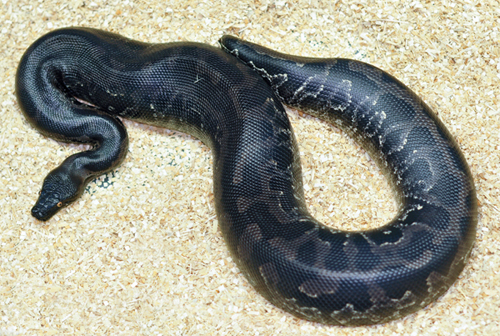
Sumatra short-tailed python. Photo by Ryan and Kara Norris
The blood python’s natural range includes eastern Sumatra and surrounding islands, peninsular Malaysia and southwest Thailand. The brilliant red coloration that gives this species its common name is not found in either of the short-tailed python species. While the very best blood pythons are noted for their striking scarlet pigmentation, they may range in color from pale yellow to brown to dark burgundy. These days, there are a myriad of blood python color and pattern morphs established in captivity, including both T+ and T- albinos, stripes and ivories, as well as combinations of various morphs.
Borneo short-tailed pythons occur on the island of Borneo, and they are commonly bred in captivity. Along with the classic wild-type form, there are several beautiful color mutations offered every season, including stripes, Ultra-Breits (a pale, reduced-pattern morph) and marbles (speckled sides with intricate, swirling dorsal markings). Although individual temperament will vary from animal to animal, Borneos are frequently noted to have fairly laid-back attitudes, even as hatchlings.
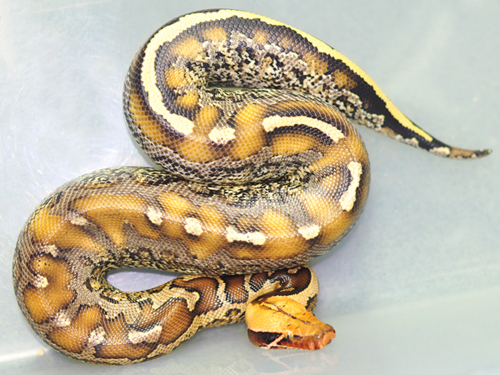
Borneo short-tailed python. Photo by Ryan and Kara Norris
Sumatran short-tailed pythons, like some blood pythons, hail from the southern and western regions of the island of Sumatra. Sumatran short-tailed pythons range in color from chocolate brown to pitch black. Some have silver heads commonly referred to as “chrome-headed” in the hobby. Another smaller race of Sumatran short-tailed pythons is noted for its lighter pigmentation and bright-orange heads. These orange-headed animals are sometimes confused with Borneo short-tails by uninitiated keepers. Both varieties of Sumatran short-tailed pythons may be lighter in coloration with contrasting patterns as hatchlings; these snakes will darken with age and size, with the most notable changes occurring in the first three years of the snake’s life. For an impressive, jet-black snake with a nice attitude, Sumatran short-tailed pythons are pretty hard to beat!
Husbandry for the two short-tailed python species is identical to that of blood pythons, and like blood pythons, the short-tails are now frequently available in the herpetocultural hobby, both from dedicated breeders as well as vendors and dealers at weekend expos.
Additional Tips
Keepers new to blood pythons should give themselves every advantage when delving into this species. This can be accomplished by selecting quality, captive-bred-and-born snakes from breeders who have significant experience in working with blood pythons. Not only do such breeders hatch beautiful and pristine blood pythons with established lineage and a track record of health and consistent feeding habits, they can also serve as your lifeline for husbandry questions and quandaries along the way.
Just for perspective, many of the blood pythons widely available in online classified ads and at weekend reptile expos are captive-hatched specimens. This means that they originated from wild-collected, gravid females that were allowed to lay eggs in captivity. The offspring from those eggs are then shipped around the world to various wholesalers and dealers. Eventually, they find their way into the pet trade. These snakes arrive with no feeding records, bloodline information or any other insight into their past. Not only does this make it difficult to pick out a true trophy specimen, it can leave a new keeper grasping at straws if something with the snake goes awry, whether feeding problems, health issues or worse. Selecting an established juvenile from a dedicated breeder can help to circumvent any of these situations, thus paving the way for a positive experience.
Ryan and Kara Norris are lifelong animal aficionados. Their collection of blood pythons and short-tailed pythons is known as The Blood Cell, where their goal is to selectively breed for beautiful snakes with calm temperaments. They have spent the past 15 years focused on the blood and short-tailed python species, and created bloodpythons.com as a resource for keepers. Visit their collection and additional husbandry information at bloodpythons.com.

